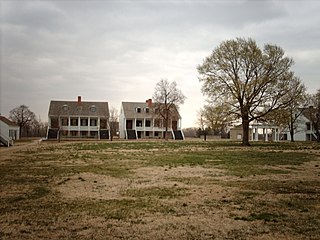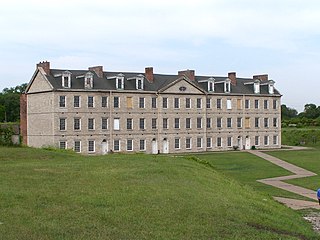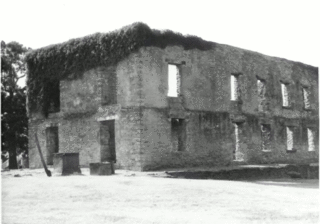
Cedar Point is a city in Chase County, Kansas, United States. As of the 2010 census, the city population was 28.

Fort Scott National Historic Site is a historical area under the control of the United States National Park Service in Bourbon County, Kansas, United States. Named after General Winfield Scott, who achieved renown during the Mexican–American War, during the middle of the 19th century the fort served as a military base for US Army action in what was the edge of settlement in 1850. For the next quarter century, it was used as a supply base and to provide security in turbulent areas during the opening of the West to settlement, a period which included Bleeding Kansas and the American Civil War.

Bent's Old Fort is an 1833 fort located in Otero County in southeastern Colorado, United States. A company owned by Charles Bent and William Bent and Ceran St. Vrain built the fort to trade with Southern Cheyenne and Arapaho Plains Indians and trappers for buffalo robes. For much of its 16-year history, the fort was the only major white American permanent settlement on the Santa Fe Trail between Missouri and the Mexican settlements. It was destroyed in 1849.

Fort Wayne is located in the city of Detroit, Michigan, at the foot of Livernois Avenue in the Delray neighborhood. The fort is situated on the Detroit River at a point where it is under half a mile to the Ontario shore. The original 1848 limestone barracks still stands, as does the 1845 fort. On the grounds but outside the original fort are additional barracks, officers quarters, hospital, shops, a recreation building, commissary, guard house, garage, and stables.

Fort Wilkins Historic State Park is a historical park operated by the Michigan Department of Natural Resources at Copper Harbor, Michigan. The park preserves the restored 1844 army military outpost, Fort Wilkins, which was placed on the National Register of Historic Places in 1970. The state park's 700 acres (280 ha) include camping and day-use facilities as well as the Copper Harbor Lighthouse, built in 1866. The park is a "Cooperating Site" of the Keweenaw National Historical Park.

Fort Griffin, now a Texas state historic site as Fort Griffin State Historic Site, was a US Cavalry fort established 31 July 1867 by four companies of the Sixth Cavalry, U.S. Army under the command of Lt. Col. S.D. Sturgis, in the northern part of West Texas, specifically northwestern Shackelford County, to give settlers protection from early Comanche and Kiowa raids. Originally called Camp Wilson after Henry Hamilton Wilson, a recently deceased lieutenant, it was later named for Charles Griffin, a former Civil War Union general who had commanded, as de facto military governor, the Department of Texas during the early years of Reconstruction.

Fort Hays, originally named Fort Fletcher, was a United States Army fort near Hays, Kansas. Active from 1865 to 1889, it was an important frontier post during the American Indian Wars of the late 19th century. Reopened as a historical park in 1929, it is now operated by the Kansas Historical Society as the Fort Hays State Historic Site.

Fort Pitt Museum is an indoor/outdoor museum that is administered by the Senator John Heinz History Center in downtown Pittsburgh, Allegheny County, Pennsylvania in the United States. It is at the confluence of the Monongahela and Allegheny Rivers, where the Ohio River is formed. Fort Pitt Museum is surrounded by Point State Park, a Pennsylvania state park named for the geographically and historically significant point that is between the rivers. This piece of land was key to controlling the upper reaches of the Ohio River Valley and western Pennsylvania, before, during and after the French and Indian War as well as the American Revolution.

Fort Washita is the former United States military post and National Historic Landmark located in Durant, Oklahoma on SH 199. Established in 1842 by General Zachary Taylor to protect citizens of the Choctaw and Chickasaw Nations from the Plains Indians it was later abandoned by Federal forces at the beginning of the American Civil War. Confederate troops held the post until the end of the war when they burned the remaining structures. It was never reoccupied by the United States military. After years in private hands the Oklahoma Historical Society bought the fort grounds in 1962 and restored the site. Today the Fort Washita Historic Site and Museum is a tourist attraction and hosts several events throughout the year.

Prairie City was a town site in southeast Douglas County, Kansas near present-day Baldwin City.

Cottonwood Township is a township in Chase County, Kansas, United States. As of the 2000 census, its population was 184.
Kansas has always been home to many forts and military posts.
In the early 1860s Stephen B. Chapman and his family lived on a farm near the town of Black Jack, south of Lawrence, Kansas. In summer 1863 Bushwhackers began traveling through the area, terrorizing the citizens. After William C. Quantrill's Lawrence Massacre on August 21, 1863, the family in September moved west, since the guerrillas passed within sight of their farm.
Fort Lincoln was established about August 24, 1861, by United States Senator James Lane. Earlier in August, Lane had reestablished Fort Scott as a military post. Soon Confederate troops under Maj. Gen. Sterling Price threatened to overrun the newly reopened post.
Fort Montgomery in the town of Eureka, Kansas was built in summer 1861 by local citizens for protection against Indian attacks and Confederate guerrilla forces.
Franklin was a small town established in 1854 in Douglas County, Kansas Territory. Established as a proslavery stronghold, the town played a key role in the "Bleeding Kansas" conflict that troubled the territory in the 1850s.
Franklin's Fort was a small fortification that had been erected in Franklin, Douglas County, Kansas by pro-slavery settlers. During the "Bleeding Kansas" period, the fort was the site of two minor battles between pro- and anti-slavery factions.

Drinkwater & Schriver Mill, also known as Cedar Point Mill, was listed on the National Register of Historic Places (NRHP) in 2006. It is located in Cedar Point, Kansas, United States.












